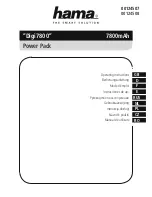
10
| English
Dust/Chip Extraction
The dust from materials such as lead paint, some types of
wood, minerals and metal can be harmful to human health.
Touching or breathing in this dust can trigger allergic reac-
tions and/or cause respiratory illnesses in the user or in
people in the near vicinity.
Certain dusts, such as oak or beech dust, are classified as
carcinogenic, especially in conjunction with wood treatment
additives (chromate, wood preservative). Materials contain-
ing asbestos may only be machined by specialists.
– Use a dust extraction system that is suitable for the ma-
terial wherever possible.
– Provide good ventilation at the workplace.
– It is advisable to wear a P2 filter class breathing mask.
The regulations on the material being machined that apply in
the country of use must be observed.
u
Avoid dust accumulation at the workplace.
Dust can
easily ignite.
Hood (see figure E)
Fit the hood
(19)
before you connect the power tool to the
dust extraction system.
Attach the hood
(19)
to the power tool so that the bracket
locks into place on the safety guard
(1)
.
Remove the hood
(19)
when working without a dust extrac-
tion system and for mitre/bevel cuts. To do this, pull the
hood forwards off the safety guard
(1)
.
Connecting the dust extraction (see figures F–G)
Fit the extraction outlet
(20)
in the recesses of the base
plate
(12)
.
Connect a dust extraction hose
(21)
(accessory) to the ex-
traction outlet
(20)
. Connect the dust extraction hose
(21)
to a dust extractor (accessory).
You will find an overview of connecting to various dust ex-
tractors at the end of these operating instructions.
For optimum dust extraction, where possible use the anti-
splinter guard
(18)
.
Switch off the sawdust blower device when you have con-
nected the dust extraction system.
The dust extractor must be suitable for the material being
worked.
When extracting dry dust that is especially detrimental to
health or carcinogenic, use a special dust extractor.
Operation
Operating modes
u
Remove the battery from the power tool before carry-
ing out work on the power tool (e.g. maintenance,
changing tool, etc.). The battery should also be re-
moved for transport and storage.
There is risk of injury
from unintentionally pressing the on/off switch.
Pendulum action settings
The pendulum action can be adjusted using four different
settings, allowing the cutting speed, cutting capacity and the
cut itself to be optimally adapted to the material that you
want to cut.
You can also adjust the pendulum action during operation
using the adjusting lever
(15)
.
Level 0
No pendulum action
Level I
Low pendulum action
Level II
Moderate pendulum action
Level III
High pendulum action
The optimum pendulum level for each application can be de-
termined by a practical test. Note the following recommend-
ations:
– Select a lower pendulum level or switch off the pendulum
action completely if you wish to produce a finer or cleaner
cutting edge.
– Switch off the pendulum action when machining thin ma-
terials (e.g. sheets).
– Work on hard materials (e.g. steel) with low pendulum ac-
tion.
– You can work on soft materials and saw wood using max-
imum pendulum action.
Adjusting the mitre/bevel angle (see figure H)
The base plate
(12)
can be swivelled to the right or left to
make mitre cuts up to 45°.
The hood
(19)
, the extraction outlet
(20)
and the anti-
splinter guard
(18)
cannot be used while mitre/bevel cuts
are being made.
– Push the extraction outlet
(20)
downwards slightly and
pull it out of the base plate
(12)
.
– Remove the hood
(19)
and the anti-splinter guard
(18)
.
– Loosen the screw
(22)
with the hex key
(11)
and slide
the base plate
(12)
slightly towards the rechargeable bat-
tery.
– To adjust mitre/bevel angles, swivel the base plate
(12)
to the required position according to the scale
(23)
.
Other mitre/bevel angles can be adjusted using a pro-
tractor.
– Then push the base plate
(12)
towards the saw
blade
(17)
as far as it will go.
– Retighten the screw
(22)
.
Moving the base plate (see figure H)
You can move the base plate
(12)
back for sawing close to
edges.
Loosen the screw of the base plate
(22)
with the hex key
(11)
and slide the base plate
(12)
all the way towards the
battery
(8)
.
Retighten the screw
(22)
.
Sawing with an offset base plate
(12)
is only possible with a
mitre/bevel angle of 0°. In addition, the parallel guide with
circle cutter
(26)
(accessory) as well as the anti-splinter
guard
(18)
must not be used.
Sawdust blower device
The cutting line can be kept clear of chips using the airflow
from the sawdust blower device.
1 609 92A 6W6 | (17.01.2022)
Bosch Power Tools











































